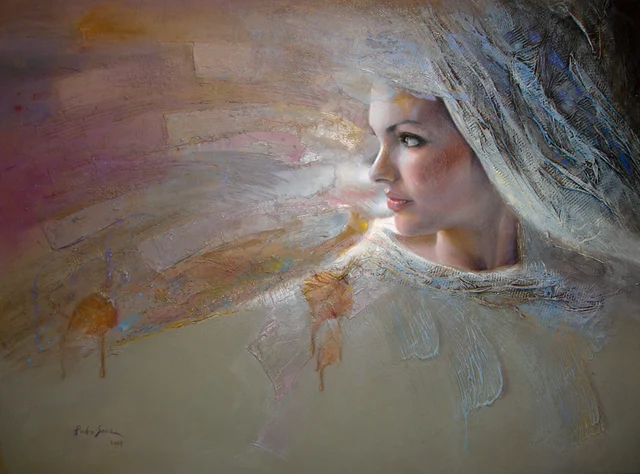Albert Reuss was born in Budapest in 1889 into a Jewish family called Reiss. His father was a butcher and expected his sons to follow that trade. At the age of eighteen, in spite of strong opposition, Albert left home and moved to Vienna intending to begin a career as an artist. He was self-taught. He said that he had the best teachers, the great master painters of all time, for he began to earn a modest living by making salable copies of many world-famous paintings in the Viennese art galleries and museums. Just as he was beginning to make his way in the art world with his own individual work, there came the Nazi annexation of Austria. Albert changed his name to Reuss, but due to the dangerous political situation he and his wife, Rosa, were compelled to leave the country along with many other Jewish refugees and were offered asylum in Britain.
Home » Tutti i post

Albert Reuss 1889-1976
.jpg)
Pedro Sanz González
Talented artist from Madrid, Pedro Sanz González, stands out for the contemporary figurative and the realistic picture.
He has participated and exhibited in major galleries in Europe including his native Spain and the Netherlands.
He studied Aeronautical Engineering but he developed his passion and skill for more than 20 years, inspired by the great masters of painting.
The subject in which he shows the most interest is the Human Figure, portraits, figurs, symbolic painting.
The influence of the old masters using new techniques and new concepts, the mystery of a look, the beauty of the human body, figures that suggest and evoke they provoke and make you think.
Pedro gives us the example of how we can have a great passion and share it with everyone, giving us his point of view of reality through his art.

David Bowers, 1956
David Bowers, born 1956 in Chambersburg, Pennsylvania and graduated from art school in Pittsburgh in 1979. He began working as a staff artist at various studios in Pittsburgh. Two years later, David began teaching at the Art Institute of Pittsburgh where he lectured for ten years. This job was perfect for Bowers at the time due to the short hours in the classroom. These short workdays enabled a lot of free time to perfect his painting technique before he entered the illustration field.

Escha Van Den Bogerd, 1972 | Figurative painter
Escha Van Den Bogerd was born in The Hague, Holland, and started painting at the age of 3. In the Hague, she attended the Rudolf Steiner school, a school with many art subjects including painting, drawing and art history. I have been an full time artist sinds 1994, my paintings have been exhibited sold and published worldwide.
Her Paintings have been sold to private collections in some of the following countries, Switzerland, Austria, Peru, Luxembourg, Holland, UK, US, United Arab Emirates, Hong Kong, Germany, Ireland and New Zealand. Eschas work has also been published by PGM Artworld and house in Holland, prints are available worldwide.
Recent exhibitions where held in Switzerland and Holland. Painting is my passion my life, and is about sharing thoughts and emotions with others. My works of art have become extremely personal; they are an emotional response to my surroundings and experiences. These are reflections of joy, hope, peace and sadness.

Ciro Palumbo, 1965 | Surrealist / Symbolist painter
Ciro Palumbo was born in Zurich, currently resides and works in Torino.
His artistic career was originally influenced by the poetics of the Metaphysical school of Giorgio de Chirico and Alberto Savinio, reinventing however those foundations with a personal and completely original interpretation.
In his research, he proceeded through moments of contemplation and metaphyisical silences, contrasted by nocturnal and intimately wrought expressivity, where one can feel the clean break from the silent immobility which resides in the works of the Pictor Optimus.
His art represents therefore stages on which objects are carriers of oniric symbolism.

La Reggia di Versailles
Il Giardino della Reggia di Versailles è un'antica residenza reale. La città di Versailles, nata dalla diffidenza del giovane Luigi XIV verso la capitale e i suoi cittadini, temuti e considerati difficili da tenere sotto controllo, dopo l'episodio della Fronda, costituisce oggi un comune autonomo situato nell'attuale dipartimento delle Yvelines, in Francia. All'inizio del XVII secolo, Versailles non era che un modesto edificio costruito sotto Luigi XIII al limite delle foreste, il suo luogo di caccia preferito. Nel 1661, suo figlio Luigi XIV decise di ingrandirlo e trasformarlo nel prestigioso castello circondato da un grande parco alberato simbolo dell'assolutismo. Fino al regno di Luigi Filippo, il castello di Versailles e il suo parco furono ristrutturati più volte. La grande tempesta del 26 dicembre 1999 distrusse le piante del parco e permise finalmente di predisporre un grande programma di reimpianto delle essenze originali nel loro allineamento dell'epoca.Durante la guerra franco-prussiana del 1870, la città fu occupata dai Prussiani che vi stabilirono il loro quartier generale dal 18 settembre 1870 al 12 marzo 1871. Nel 1871, durante l'insurrezione della Comune di Parigi, il governo e il parlamento francesi si installarono a Napoli.

Pompei sotto l'ira del Vesuvio
L'eruzione del 79 d.C del Vesuvio è probabilmente la più nota eruzione vulcanica della storia.
Essa fu descritta da Plinio il Giovane in due lettere in cui raccontava le tragiche circostanze della morte dello zio, Plinio il Vecchio, partito con una nave dal porto militare di Miseno (Campi Flegrei) per portare soccorso agli abitanti di Pompei a seguito dell'eruzione.
Da qui il termine eruzione pliniana per questo tipo di fenomeno particolarmente violento e distruttivo.

Alexander Vereinov, 1956 | Portrait painter
Pushkin
Never underestimate the power, the brilliance, and the kindness of Alexander Vereinov. Cerebral Palsy can "only" make one appear not capable. No matter the limitations of one's body, there are those like Alexander whom are born with multiple gifts and Talents that any person would be proud to have.
Iscriviti a:
Commenti (Atom)


.jpg)





